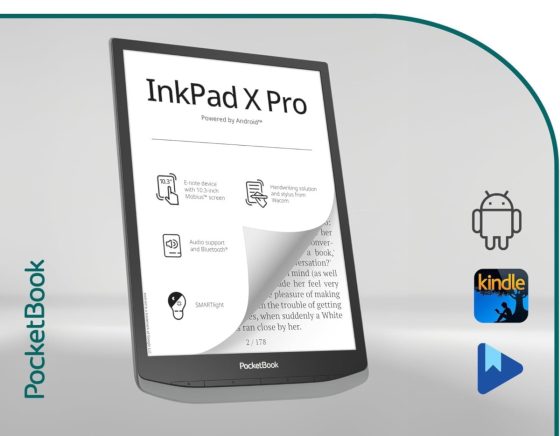PocketBook recently released a new 10.3-inch ereader and eNote called the PocketBook InkPad X Pro. It’s PocketBook’s first notetaking device, and it’s also their first Android-based ereader.
PocketBook has uploaded some “how to” videos to their YouTube channel showing the new InkPad X Pro in action, and I’m not sure the videos are doing a good job of making the device look appealing.
I’ve been critical of the InkPad X Pro since PocketBook announced it and said they’d be using an older version of Android from 2017, Android 8.1. The overall specs are kind of disappointing as well, especially compared to Onyx’s Android devices.
However, the InkPad X Pro has some unique things going for it. First off, it has physical page-turn buttons, unlike all the other 10″ eNotes on the market, and it’s also the only one using a flexible Mobius screen from E Ink instead of the cheaper and easier-to-break Carta screens that everyone else is using.
When eNotes first started coming out, they used Mobius screens for increased durability since they don’t crack like standard glass-backed E Ink screens. They also come with the benefit of being lighter. The InkPad X Pro only weighs 350 grams, which is nearly 100 grams lighter than the Kindle Scribe.
One downside with Mobius-equipped devices is they are more expensive. The PocketBook InkPad X Pro sells for $420 on Amazon, which is $20 higher than the Kobo Elipsa 2E and Onyx Note Air3, and $80 more than the Kindle Scribe.
I’m not sure how many people are going to be interested in a device that runs such an old version of Android and costs more than most other eNotes, especailly the new Note Air3, which is superior in just about every way, and it runs Android 12 instead of Android 8.1.
Given that, I have no plans on spending $420 to review the InkPad X Pro, but it’s interesting how much you can learn just from watching the videos that PocketBook has uploaded. First off, the InkPad X Pro clearly has an indented screen, which is something that you don’t usually see on eNotes. Onyx’s first Note model had an indented screen, and it was possible to scratch and leave permanent indentions when pressing down too hard with the stylus, so it makes you wonder if that’s going to be an issue on this model too.
Another detail, it comes with one of those super cheap plastic styluses that Onyx’s devices used to come with. It works well enough but they couldn’t make it feel any cheaper if they tried, and it doesn’t magnetically attach to the side of the device like the stylus that comes with most other eNotes.
The device also looks pretty slow and laggy in the videos. There’s usually a noticeable delay when selecting things, and you can’t help but notice they speed up the video every time the keyboard is in use so you know that’s got to be painful to use, and highlighting looks as clunky as ever.
There are some things to like about the InkPad X Pro, but it’s hard to see it being able to compete with more established eNotes at this point.


Do you think that company will fall soon? Lately they are launching outdated devices (Inkpad Color 2) and I fear they will dissappear and will not release more updates
PocketBook seems to have had a generally good year to me, with the only hardware misstep being the InkPad Color 2 and that might have been down to their display suppliers, viz E-Ink. (They were already let down by E-Ink with the Gallery 3!) The InkPad X Pro might be another goof, if they release it.
The Verse and Verse Pro seem like good devices in their size category. There are some signs that they are improving performance with the InkPad 4, although the videos of the InkPad X Pro makes that look dog slow.
Their new hardware design seems sharp.
Their software seems to be improving with dark mode support. Releasing the InkPad X Pro with an obsolete version of Android seems a bit strange…
Definitely not. In Europe they are one of the most popular ereader brands, for example here in Czechia you can mostly see Kindles and Pocketbooks and bookstores mainly sell Pocketbooks. On the contrary you will almost never see Kobo or Onyx here.
Their ereaders are pretty bad, but people love them because of how great they are for sideloading. Which is important in countries like ours where almost all the ebooks you can buy from bookstores come without DRM.
Pocketbook isn’t going anywhere.
But they aren’t updating their sotfware much. The reflow in their reader software is desperately slow, which is strange being Linux.
I honestly don’t see much they should update. Their readers are extremely slow, but software-wise they do all they should do. Software updates were never issue for me with PocketBook.
But if their ereaders are slow, its cause is its software, isn’t it? That is what they should update
One of those brands that have been around forever while continually selling subpar devices with slow, buggy software and no real form of quality control.
I wonder who on earth is forced to use these things for lack of alternatives.
I don’t know which Pocketbooks you’ve been using but I’ve found them to be rock solid in terms of the software. The Inkpad 3 has a fragile screen but that’s not something Pocketbook can change, it’s a result of the technology.
I think I gave up on the with the Ultra. Ever since then I’ve been wondering how they’re still in business.
I have InkPad 3 Pro. It’s literaly the slowest ereader I have ever seen. Just pure trash.